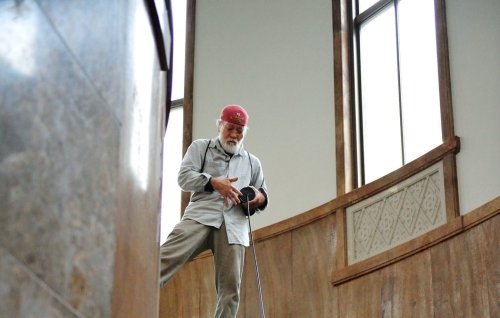The first evening of Voices and Echoes brings together pioneering Japanese artists Akio Suzuki, Gozo Yoshimasu, and Otomo Yoshihide. Sound artist Akio Suzuki will perform on a range of unique instruments including an Iwabue, the ancient stone flute passed down through his family for many generations and the Analapos, an instrument he invented in the 1970s that creates echoes through the acoustic transmissions of a spiral cord stretched between two metal cylinders. Experimental poet Gozo Yoshimasu will perform works utilizing his unique vocalization style of recitation, which relies upon a highly rhythmic delivery and intense vocal modulations. Yoshimasu will perform in collaboration with Otomo Yoshihide, an experimental guitarist/turntablist and leading international figure in the fields of contemporary noise and improv.
Akio Suzuki is known as a pioneer of sound art, but the breadth of his activities and the form of his works far exceeds the normal boundaries of sound art. It is perhaps more as a “quester after sound and space” that he has received the most attention from artists in many fields. Suzuki’s journey as an artist began in 1963 with a performance at Nagoya station, in which he threw a bucket full of junk down a staircase. The inspiration behind this performance— the idea that if one were to hurl an object down a well-balanced stairway, a pleasant rhythm might be the result— took the desire to “listen” as its subject. That desire to hear, to listen has remained the one constant in Suzuki’s stance as an artist. During the sixties, Suzuki’s sense of playfulness led him to undertake a series of Self-Study Events, where he explored the processes of “throwing” and “following”, taking the natural world as his collaborator. The experiences he gained in these events led him in the seventies to invent an echo instrument he named Analapos. The instrument’s structure resembles that of two mirrors facing each other, reflecting into infinity. As an extension of the principles underlying Analapos, Suzuki constructed the Hinatabokko no kukan (Space in the Sun) in 1988. This space consists of two huge parallel walls, in between which the artist can sit all day and purify his hearing by listening to the reflected sounds of nature. This space leads the artist to discover a new method of listening. Suzuki himself comments, “Sound, which had been conceptually imprisoned in various spaces, is freed to circle the world.”
Gozo Yoshimasu, considered one of the most representative figures of Japanese modern literature, has published over thirty books of poetry— among them works that have been available in several languages– since the release of his first book of poetry in 1964 at the age of twenty-five. His poetry, which he challenges himself to constantly reinvent and reinvigorate, chronicles a tireless pursuit of origins. He also explores the idea of always being in movement. As a traveler his itineraries have initially followed those of the great 17th century Japanese poet Basho to widen to a more personal ‘pilgrimage’ from the isles of Japan to the American desert, Central Asia or simply common streets in most continents in the world. It’s no wonder that this constant movement— walking, driving, traveling by train or boat, is one of the foundations of his poems giving them a sense of rhythm, speed in “the pursuit of his desire to go far away”(from his poem Weaver Girl). He has also developed his poetry into other forms of artistic expression. As a performer, he has cultivated a unique style of recitation, and uses rhythm and vocal modulation to the extent that one might consider it a form of incantation. His voice, at times gentle at times feverish lands itself of a fascination meeting with music. His readings have been called “electrifying revelations of the power of poetry to move the heart and mind without the air of translation.”
Otomo Yoshihide is one of the most well known Japanese musicians and composers in the experimental music field. Performing with guitar, turntables, and electronics he first came to international prominence in the 1990s as the leader of the noise rock group Ground Zero, and has since worked in a variety of contexts, ranging from free improvisation to noise, jazz and contemporary classical. A pioneering figure in onkyo and electroacoustic improvisation scenes, Otomo has been featured on important records on labels such as Improvised Music from Japan and Erstwhile. He studied at the Meiji University from 1979, where he studied ethnomusicology, concentrating on the Japanese pop music of World War II and the development of musical instruments during the Chinese Cultural Revolution. Samples of instruments and music from this period are found in several of his works. He played in rock bands while at college, but turned to improvisation after discovering free jazz and free improvisation musicians like guitarist Derek Bailey, saxophonist Kaoru Abe and guitarist Masayuki Takayanagi.



